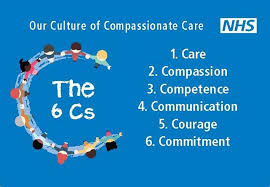6 Cs In Care
Treatment of the C6-C7 spinal motion segment includes both surgical and nonsurgical methods. Usually, nonsurgical methods are tried first. Surgery may be considered when nonsurgical treatments fail to relieve pain or in cases where severe spinal cord or C7 nerve damage progresses.
See Treatment for Neck Pain
- And is asso ciated wit h care, c ourage, competence a nd comm itment, t hus ful fill ing. The 6Cs of nursi ng. The patient as sessment pro cess is rel iant on.
- 30.6.11 - Emergency Department Visits (Codes 99281 - 99288) 30.6.12 - Critical Care Visits and Neonatal Intensive Care (Codes 99291 - 99292) 30.6.13 - Nursing Facility Services. 30.6.14 - Home Care and Domiciliary Care Visits (Codes 99324 - 99350) 30.6.14.1 - Home Services (Codes 99341 - 99350).

Care by other care professionals involved in a persons care. We also need to be competent in a constantly evolving range of tools that impact directly on care and/or how we identify and communicate the care that is needed or has been given. We need to develop competency in measuring the effectiveness of what we do, developing and using.
Herniation of the C6-C7 intervertebral disc may irritate or compress the C7 nerve root causing pain and other symptoms. SeeCervical Herniated Disc Symptoms and Treatment Options
Nonsurgical Treatment for C6-C7
Common nonsurgical treatments of the C6-C7 motion segment include:

- Pain Management. Pain in C6-C7 may originate from bones, nerves, or muscles, sometimes persisting for months. A few methods to control this pain are:
- Medication. Both over-the-counter (OTC) and prescription medications are used to treat pain stemming from C6-C7. Nonsteroidal anti-inflammatory drugs (NSAIDs), opioids, tramadol, and/or corticosteroids are a few examples of pain-relieving medications that may be used.
See Medications for Back Pain and Neck Pain
- Injection. Spinal nerve pain from C7 may be treated with steroid injections in the epidural space, around the C7 nerve itself, or injections into the facet joint of the C6 and C7 vertebrae. Risks of these injection procedures include hematoma, bleeding, and nerve damage. Fluoroscopic (x-ray) guidance with radiopaque contrast dye is usually used for correct needle placement and helps to improve diagnostic accuracy and decrease procedural risks.
- Medication. Both over-the-counter (OTC) and prescription medications are used to treat pain stemming from C6-C7. Nonsteroidal anti-inflammatory drugs (NSAIDs), opioids, tramadol, and/or corticosteroids are a few examples of pain-relieving medications that may be used.
- Immobilization. Using a neck brace or collar after an acute injury, such as fracture, may help promote healing of tissues and prevent further injury.
Watch: Cervical Collars for Neck Pain Video
- Physical therapy. Physical therapy can help strengthen neck muscles, improve posture, and increase range of motion after a C6-C7 motion segment injury. Physical therapy is usually performed under the guidance of a physical therapist and may include exercises, stretches, manual therapy, massage, and/or other treatments.
See Physical Therapy for Neck Pain Relief
6 Cs In Care Act
Other nonsurgical treatments include cervical traction, acupuncture, transcutaneous electrical nerve stimulation (TENS), cognitive behavioral therapy, and biofeedback.
Surgical Treatment for C6-C7
Cervical spine surgery may be considered as a treatment of last resort in cases when a nerve root or spinal cord compression causes or worsens neurological deficits. A few examples include worsening numbness and/or weakness in the arm or problems with walking or coordination. Surgery may also be performed to improve stability of the neck after severe fracture or dislocation.
See Surgery for Neck Pain
Common surgeries performed in the C6-C7 motion segment include:
6 Cs In Care Facilities
- Surgery to remove all or part of a disc. Removal of a herniated or degenerated disc may help relieve pressure on compressed nerve roots, reducing radicular pain. Disc surgeries include:
- Anterior cervical discectomy and fusion (ACDF)
- Cervical artificial disc replacement (ADR)
- Posterior cervical decompression
While some procedures involve removal of a portion of the disc, most cervical spine surgeries include removal of the entire disc and replacement with a bone graft (for fusion) or artificial disc. The adjacent vertebrae may be fused with plates and screws following the disc procedure.
- Surgery on the vertebrae. Removal of portions of overgrown bone (bone spurs) and/or removing part of a vertebra may help relieve pressure on compressed nerves. A few examples of surgeries on the vertebrae are:
- Laminectomy
6 Cs In Care Home Health
Depending on the severity or location of the injury, one or more procedures may be performed at the same time. In many cases, symptom relief is experienced within a few weeks after surgery.
6 C's Compassion In Care
The risks of serious complications such as excessive bleeding, paralysis, infection, and others must be understood before proceeding with surgery.